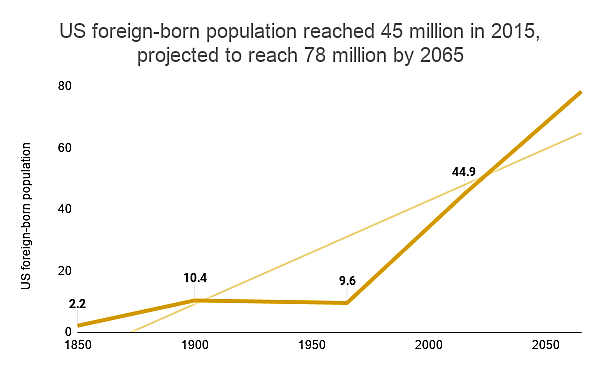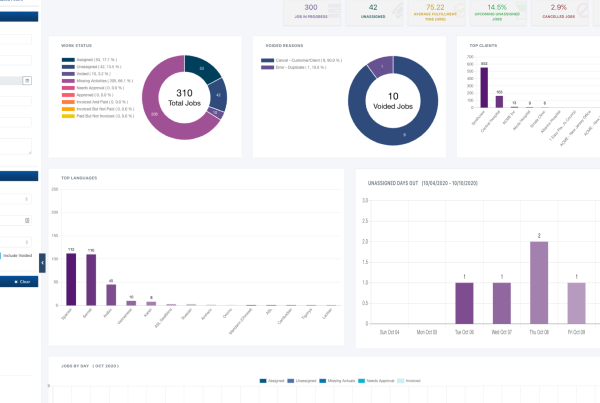This is the second part of a blog series that explores the 2021 “Healthcare Consumerism in a Multilingual Market” Report. This post will provide a market analysis of demographic and immigration trends in the increasingly multilingual healthcare consumer base.
In order to fully understand the impact of the rise of healthcare consumerism, one must analyze the most critical component of the new healthcare market: the consumer base. The results of the 2020 census show that, due to declining birth rates, slow population growth, and an aging population, the United States will have to rely on increased rates of immigration in the coming decades to make up for labor shortages and boost a graying economy.
This means an increasingly diverse base of healthcare consumers — both linguistically and culturally — and an opportunity for the healthcare industry to adapt to a changing marketplace.
Population Growth Decline and Immigration Trends in the United States
The figures from the 2020 census show that, between 2010 and 2020, the US population increased at a rate of just 7.4%, the lowest rate since the Great Depression. In fact, birth rates in the US have consistently declined by an average of 2% per year since 2014, falling to “the lowest number of births since 1979,” according to the National Center for Health Statistics. Jonathan Vespa, a demographer with the U.S. Census Bureau, estimates that by 2034 “older people are projected to outnumber children for the first time in [US] history.”
In another demographic first, “net international migration is projected to overtake natural increase in 2030 as the primary driver of population growth in the United States.” The demographic trends of declining birth rates, slow population growth, and an aging population all point to an imminent rise in immigration.
The Benefits of International Migration
The consensus among economists holds that “population growth fuels economic growth in wealthy countries.”
Without immigration-driven population growth, the US will suffer the consequences of population decline such as labor shortages and a shrinking tax base, making it harder for government budgets to maintain infrastructure, provide essential services, and properly fund public schools. Danilo Zak, a senior policy associate for the National Immigration Forum, asserts that “immigration is one of the most feasible and rational ways to help respond” to the challenge of population growth decline which he calls “one of the most pressing challenges the country will face over the next several decades.”
Immigrants are not only a reliable driver of population growth, they are also a powerful force for “economic dynamism.” Immigrants are almost twice as likely to start a new business as native-born U.S. citizens, and “more likely to work in essential industries such as health care, transportation, construction, agriculture, and food processing.”
According to projections from the Pew Research Center, by 2065, the US population will reach an estimated 441 million people, of whom 78 million will be immigrants and 81 million will be people born in the U.S. to immigrant parents. This means that “about one-in-three Americans would be an immigrant or have immigrant parents, compared with one-in-four” in 2015.
The Economic Impact of the Refugee Community
The United States is beginning to reverse course, increasing the cap on refugees allowed into the country to 62,500 for Fiscal Year 2021.
As our demographic analysis shows, it is not a question of politics but of population. The US will need to allow more immigrants and refugees into the country in order to make up for labor shortages, a low birth rate, and an aging population. Furthermore, the refugee population is widely misunderstood in terms of its consumer buying power, and any reasonable market analysis must take pains to correct the misguided notion that refugees are a “drain on the American society.”
According to data from the New American Economy, “refugees have an entrepreneurship rate that outshines even that of other immigrants” with 13% of refugees owning businesses as compared to 11.5% of non-refugee immigrants and 9% of the U.S.-born population. In 2015, refugee households earned $77.2 billion, of which $6.4 billion went to state and local taxes and $14.5 billion went to federal taxes, leaving the resettled refugee population with $56.3 billion in spending power.
The projected rise in immigration and refugee resettlement over the coming decades represents an opportunity for healthcare providers to reach out to a growing sector of the market.
Looking forward, it is clear that the United States is projected to become even more culturally and linguistically diverse. By implementing language-based strategies to communicate with potential consumers, healthcare providers can capitalize on the trend of healthcare consumerism and solidify the brand loyalty of multiple linguistic groups at once.
Improving Outcomes through Effective Communication — Welcome to Propio
In order for patients to feel empowered, healthcare providers must communicate directly with — and engage — the patient population. Effective communication with patients throughout their medical experience yields tangible benefits including improved health outcomes and lower medical costs. Patient engagement leads to patient empowerment and improved patient care. This is especially important for the limited-English proficient (LEP) patient population that has been traditionally marginalized in the US healthcare system. For that reason, it is imperative to partner with a language service provider (LSP) with specialized knowledge about the Healthcare and Life Sciences industries. Welcome to Propio.
With over 20 years of experience in healthcare language services, Propio has mastered the art and science of connecting healthcare providers to their diverse patient population. We continue to lead the way, ensuring both healthcare practitioners and their patients are heard and understood. We work with a wide range of healthcare providers and offer professional multilingual solutions in over 200 languages. Whether you require in-person, over-the-phone, or remote healthcare interpreting, specialized translation or localization services, we have you covered.








